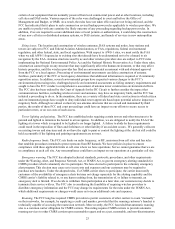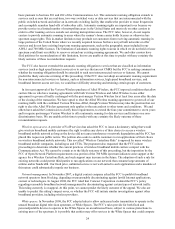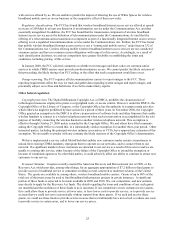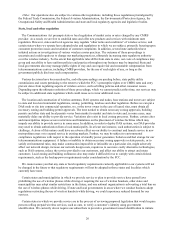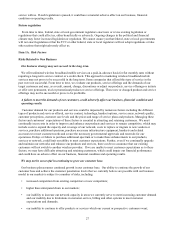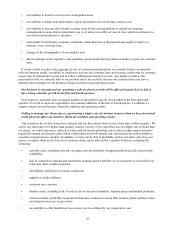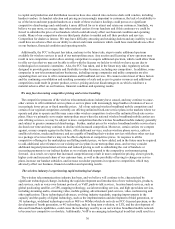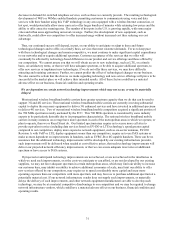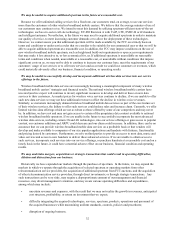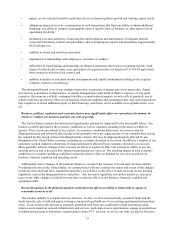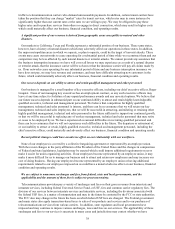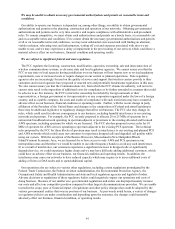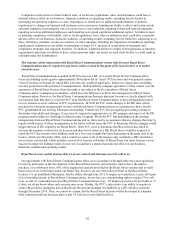Metro PCS 2008 Annual Report Download - page 41
Download and view the complete annual report
Please find page 41 of the 2008 Metro PCS annual report below. You can navigate through the pages in the report by either clicking on the pages listed below, or by using the keyword search tool below to find specific information within the annual report.32
We may be unable to acquire additional spectrum in the future at a reasonable cost.
Because we offer unlimited calling services for a fixed rate, our customers tend, on average, to use our services
more than the customers of other wireless broadband mobile carriers. We believe that the average minutes of use of
our customers may continue to rise. We intend to meet this demand by utilizing spectrum-efficient state-of-the-art
technologies, such as six-sector cell site technology, EV-DO Revision A with VoIP, LTE, EVRC-B or 4G handsets
and intelligent antennas. Nevertheless, in the future we may need to acquire additional spectrum in order to maintain
our quality of service, to meet increasing customer demands or to allow the deployment of these technologies.
However, we cannot assure you that additional spectrum will be made available by the FCC on a timely basis on
terms and conditions or under service rules that we consider to be suitable for our commercial uses or that we will be
able to acquire additional spectrum at a reasonable cost. In addition, the FCC may impose conditions on the use of
new wireless broadband mobile spectrum, such as heightened build-out requirements or open access requirements
that may make it less attractive to, or less economical for, us. If additional spectrum is unavailable on reasonable
terms and conditions when needed, unavailable at a reasonable cost, or unavailable without conditions that impose
significant costs on us, we may not be able to continue to increase our customer base, meet the requirements of our
customers’ usage of our services or to offer new services and as a result we could lose customers or revenues, which
could materially adversely affect our business, financial condition, or operating results.
We may be unable to successfully develop and incorporate additional wireless data services into our service
offerings in the future.
Wireless broadband mobile data services are increasingly becoming a meaningful component of many wireless
broadband mobile carriers’ strategies and financial results. The national wireless broadband mobile carriers have
invested (and we expect will continue to invest) significant resources to develop and deliver these on new data
services to their customers. As market prices for wireless voice services continue to decline, if we are unable to offer
such new data services we may not have additional revenue to offset the decline in wireless voice revenues.
Similarly, as customers increasingly demand wireless broadband mobile data services as part of the core feature set
of their wireless services, the failure to offer such services could reduce sales and increase churn. Currently, we offer
limited wireless data offerings which are not as robust as those offered by some of our competitors and may never
be. In addition, we have not and may not gain access to certain of the proprietary data content available to national
wireless broadband mobile operators. If we are unable in the future to successfully incorporate the most advanced
wireless data services, including certain 3G and 4G technologies, into our service offerings or gain access to popular
content, our customer additions and ARPU could decrease and our churn could increase. In addition, there can be no
assurance that we can provide wireless broadband mobile data services on a profitable basis or that vendors will
develop and make available to companies of our size popular applications and handsets with features, functionality
and pricing desired by customers. Furthermore, we rely on third parties to provide us access to most data, music and
video services and access to new handsets to deliver these advanced services. If we are unable to obtain access to
such services, incorporate such services into our service offerings, or purchase handsets at a reasonable cost and on a
timely basis in the future, it could have a material adverse effect on our business, financial condition and operating
results.
We may undertake mergers, acquisitions or strategic transactions that could result in operating difficulties,
dilution and distraction from our business.
Historically we have expanded our markets through the purchase of spectrum. In the future, we may expand the
markets in which we operate through the acquisition of selected spectrum or operating markets from other
telecommunication service providers, the acquisition of additional spectrum from FCC auctions, and the acquisition
of other telecommunication service providers; through direct investments; or through strategic transactions. Any
such transactions can be very risky, may require a disproportionate amount of our management and financial
resources, may divert management’s attention, and may create various operating difficulties and expenditures,
among which may include:
• uncertain revenues and expenses, with the result that we may not realize the growth in revenues, anticipated
cost structure, profitability, or return on investment that we expect;
• difficulty integrating the acquired technologies, services, spectrum, products, operations and personnel of
the acquired businesses while maintaining uniform standards, controls, policies and procedures;
• disruption of ongoing business;



